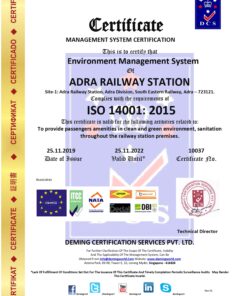Sale!
ISO 14001 : Environmental Management System
Original price was: ₹15,000.00.₹9,990.00Current price is: ₹9,990.00.
ISO 14001 is an international standard that specifies requirements for an Environmental Management System (EMS). An EMS is a systematic approach to managing the environmental aspects of an organization’s activities, products, and services. The purpose of implementing ISO 14001 is to help organizations identify, manage, monitor, and improve their environmental performance.
Here are some key aspects and components of ISO 14001:
1. **Environmental Policy**: The organization must establish and maintain an environmental policy that includes a commitment to compliance with legal and other requirements, prevention of pollution, and continual improvement.
2. **Environmental Aspects**: The organization must identify its environmental aspects, which are elements of its activities, products, or services that can interact with the environment. These aspects are then evaluated based on their significance to determine which ones require control.
3. **Legal and Other Requirements**: The organization must identify and keep up-to-date with applicable legal requirements and other requirements related to its environmental aspects.
4. **Objectives and Targets**: Based on its environmental aspects and legal requirements, the organization must establish environmental objectives and targets to improve its environmental performance continually.
5. **Environmental Management Programs**: The organization must develop and implement environmental management programs to achieve its objectives and targets. These programs should include roles, responsibilities, resources, and timeframes.
6. **Monitoring and Measurement**: The organization must monitor and measure its environmental performance against its objectives and targets. This can involve regular inspections, audits, and data collection.
7. **Communication**: The organization must establish processes for internal and external communication relevant to its EMS. This includes communicating its environmental policy, objectives, and performance to employees, stakeholders, and the public as appropriate.
8. **Documentation and Record Keeping**: The organization must maintain documented information to support the operation and effectiveness of its EMS. This includes its environmental policy, objectives, programs, procedures, records of training, and monitoring results.
9. **Internal Audit**: The organization must conduct internal audits of its EMS at planned intervals to ensure its conformity and effectiveness. This helps identify areas for improvement and corrective actions.
10. **Management Review**: Top management must review the organization’s EMS at planned intervals to ensure its continuing suitability, adequacy, and effectiveness. Management reviews help to ensure that the EMS aligns with the organization’s environmental policy and objectives and that necessary improvements are made.
Implementing ISO 14001 can bring several benefits to an organization, such as:
– **Reduced Environmental Impact**: By identifying and managing environmental aspects and impacts, organizations can reduce their environmental footprint.
– **Compliance with Legal Requirements**: Ensuring compliance with environmental laws and regulations helps avoid potential legal issues and penalties.
– **Cost Savings**: Improving resource efficiency and reducing waste can lead to cost savings.
– **Enhanced Reputation**: Demonstrating commitment to environmental responsibility can enhance an organization’s reputation among stakeholders, customers, and the public.
– **Competitive Advantage**: ISO 14001 certification can provide a competitive advantage by demonstrating environmental leadership and commitment to sustainability.
To achieve ISO 14001 certification, organizations typically undergo a certification process with an accredited third-party certification body. This process involves an initial assessment, implementation of the EMS, internal audits, and a final certification audit.
Remember, ISO 14001 is a flexible standard that can be adapted to suit the specific needs and circumstances of different organizations. It’s not about achieving perfection but about demonstrating a commitment to continual improvement in environmental performance.00










Reviews
There are no reviews yet.